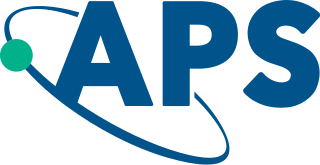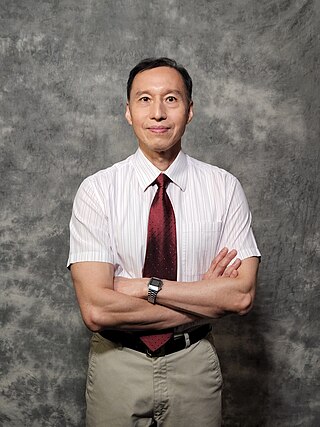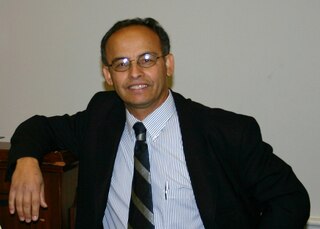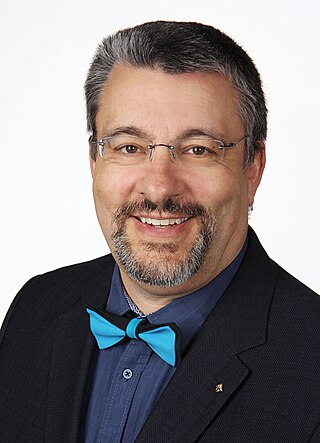Related Research Articles

The American Physical Society (APS) is a not-for-profit membership organization of professionals in physics and related disciplines, comprising nearly fifty divisions, sections, and other units. Its mission is the advancement and diffusion of knowledge of physics. The society publishes more than a dozen scientific journals, including the prestigious Physical Review and Physical Review Letters, and organizes more than twenty science meetings each year. APS is a member society of the American Institute of Physics. Since January 2021 the organization has been led by chief executive officer Jonathan Bagger.

Paul K. Chu (朱劍豪) is a specialist in plasma surface modification and materials science. He is Chair Professor of Materials Engineering in the Department of Physics, Department of Materials Science & Engineering, and Department of Biomedical Engineering at City University of Hong Kong.
John Myrick Dawson was an American computational physicist and the father of plasma-based acceleration techniques. Dawson earned his degrees in physics from the University of Maryland, College Park: a B.S. in 1952 and Ph.D. in 1957. His thesis "Distortion of Atoms and Molecules in Dense Media" was prepared under the guidance of Zaka Slawsky.
The IEEE Marie Sklodowska-Curie Award is a Technical Field Award that was established by the IEEE Board of Directors in 2008. This award may be presented for outstanding contributions to the field of nuclear and plasma sciences and engineering. This award may be presented to an individual, individuals on a team, or up to three multiple recipients. Recipients of this award receive a bronze medal, certificate, and honorarium. This award was presented for the first time in 2011.

Mounir Laroussi is a Tunisian-American scientist. He is known for his work in plasma science, especially low temperature plasmas and their biomedical applications.
Ronald Crosby Davidson was a Canadian physicist, professor, and scientific administrator who worked in the United States. He served as the first director of the MIT Plasma Science and Fusion Center from 1978 to 1988, and as director of the Princeton Plasma Physics Laboratory from 1991 to 1996. He had been Professor of Astrophysical Sciences at Princeton University since 1991.
Chandrashekhar "Chan" Janardan Joshi is an Indian–American experimental plasma physicist. He is known for his pioneering work in plasma-based particle acceleration techniques for which he won the 2006 James Clerk Maxwell Prize for Plasma Physics and the 2023 Hannes Alfvén Prize.
Norman Rostoker was a Canadian plasma physicist known for being a pioneer in developing clean plasma-based fusion energy. He co-founded TAE Technologies in 1998 and held 27 U.S. Patents on plasma-based fusion accelerators.

Stefan Ritt is a German physicist and head of the muon physics group at the Paul Scherrer Institute, Aargau, Switzerland. He is member of the MEG experiment and co-spokesperson of the Mu3e experiment. He is best known for the development of the DRS4 Switched Capacitor Array Chip, as primary author of the MIDAS Data Acquisition System and as author of the ELOG Electronic Logbook. He is co-author of two patents related to Switched Capacitor Array Circuits and their calibration.
Tihiro Ohkawa was a Japanese physicist whose field of work was in plasma physics and fusion power. He was a pioneer in developing ways to generate electricity by nuclear fusion when he worked at General Atomics. Ohkawa died September 27, 2014, in La Jolla, California, at the age of 86.
Hermann August Grunder is a Swiss-American nuclear and accelerator physicist. Dr. Hermann A. Grunder was the founding director of Thomas Jefferson National Accelerator Facility and a Director Emeritus of Argonne National Laboratory.

Sekazi Kauze Mtingwa: is an American theoretical high-energy physicist. He is a co-recipient of the 2017 Robert R. Wilson Prize for Achievement in the Physics of Particle Accelerators. He is the first African-American to be awarded the prize. Mtingwa was elected a Fellow of the American Physical Society (APS) in 2008 for "his definitive treatment of Intrabeam scattering, his contributions to the wakefield acceleration, and his early recognition of the fixed target physics potential of the next generation electron-positron collider." He also co-founded the National Society of Black Physicists in 1977 and served in various other national and international initiatives.
Phillip A. Sprangle is an American physicist who specializes in the applications of plasma physics. He is known for his work involving the propagation of high-intensity laser beams in the atmosphere, the interaction of ultra-short laser pulses from high-power lasers with matter, nonlinear optics and nonlinear plasma physics, free electron lasers, and lasers in particle acceleration.

Victor Malka is a French plasma physicist and a pioneer in laser plasma acceleration. In 2004, Malka demonstrated that high energy monoenergetic electron beams could be generated using the technique of laser wakefield acceleration, and subsequently used them to develop compact X-ray and gamma radiation sources with applications in medicine, security technology and phase-contrast imaging. For these contributions to the field, he was awarded the IEEE Particle Accelerator Science and Technology Award in 2007, the Julius Springer Prize for Applied Physics in 2017, and the Hannes Alfvén Prize in 2019.
Warren Bicknell Mori is an American computational plasma physicist and a professor at the University of California, Los Angeles. He was awarded the 2020 James Clerk Maxwell Prize for Plasma Physics for his contributions to the theory and computer simulations of non-linear processes in plasma-based acceleration using kinetic theory, as well as for his research in relativistically intense lasers and beam-plasma interactions.
Yitzhak Maron is a plasma physicist and a professor at the Weizmann Institute of Science. He is known for pioneering spectroscopic techniques to measure and characterize plasmas under extreme conditions which won him the 2007 IEEE Plasma Science and Applications (PSAC) Award and the 2009 John Dawson Award for Excellence in Plasma Physics Research.

Edl Schamiloglu is an American physicist, electrical engineer, pulsed power expert, inventor, and distinguished professor in the department of electrical and computer engineering at the University of New Mexico. He has been known in public media for his expertise in the design and operation of directed-energy weapons. He is also known for his assessment on the possible origins of alleged health damages presumably caused on U.S. embassy personnel in Cuba in 2016 as part of the Havana syndrome incident. He is the associate dean for research and innovation at the UNM School of Engineering, where he has been a faculty since 1988, and where he is also special assistant to the provost for laboratory relations. He is also the founding director of the recently launched UNM Directed Energy Center. Schamiloglu is a book author and co-editor, and has received numerous awards for his academic achievements. He is a Fellow of the Institute of Electrical and Electronics Engineers and the American Physical Society.
David A. Hammer is the J. Carlton Ward, Jr. Professor of Nuclear Energy Engineering, in the Cornell University College of Engineering. In 2004, Hammer received the Institute of Electrical and Electronics Engineers Plasma Science and Applications Committee Award, as well as the Distinguished Career Award from Fusion Power Associates in 2018.

Ilan Ben-Zvi is an accelerator physicist and academic. He was the associate chair for accelerator R&D at the Collider-Accelerator Department (C-AD), and is a distinguished scientist emeritus at the Collider-Accelerator Department (C-AD) at Brookhaven National Laboratory.
References
- ↑ "John Cary". 5 April 2016. Archived from the original on 23 October 2019. Retrieved 23 October 2019.
- ↑ "Tech-X - Management". Archived from the original on 2021-02-18. Retrieved 2019-10-23.
- ↑ "CURRICULUM VITAE of JOHN ROBERT CARY" (PDF). January 2019. Archived (PDF) from the original on 29 November 2020. Retrieved 14 February 2021.
- ↑ "John R Cary - Google Scholar". scholar.google.com. Archived from the original on 2020-10-11. Retrieved 2020-10-10.
- ↑ Geddes, C. G. R.; Toth, Cs.; van Tilborg, J.; Esarey, E.; Schroeder, C. B.; Bruhwiler, D.; Nieter, C.; Cary, J.; Leemans, W. P. (September 2004). "High-quality electron beams from a laser wakefield accelerator using plasma-channel guiding". Nature. 431 (7008): 538–541. Bibcode:2004Natur.431..538G. doi:10.1038/nature02900. ISSN 0028-0836. OSTI 836978. PMID 15457252. S2CID 4342539. Archived from the original on 2021-02-18. Retrieved 2020-10-10.
- ↑ "Highlights". Nature. 432 (7020): 943. December 2004. Bibcode:2004Natur.432..943.. doi: 10.1038/432943a . ISSN 0028-0836.
- ↑ Cary, John R.; Escande, D. F.; Tennyson, J. L. (1986-11-01). "Adiabatic-invariant change due to separatrix crossing". Physical Review A. 34 (5): 4256–4275. Bibcode:1986PhRvA..34.4256C. doi:10.1103/physreva.34.4256. ISSN 0556-2791. PMID 9897774. Archived from the original on 2021-02-18. Retrieved 2020-10-10.
- ↑ Arnold, V. I. (1988). Geometrical Methods in the Theory of Ordinary Differential Equations. Grundlehren der mathematischen Wissenschaften. Vol. 250. doi:10.1007/978-1-4612-1037-5. ISBN 978-3-540-78038-0.
- ↑ "APS Fellow Archive". www.aps.org. Archived from the original on 2020-05-09. Retrieved 2020-10-10.
- ↑ "Nuclear & Plasma Sciences Society | Particle Accelerator Science and Technology (PAST)". ieee-npss.org. Archived from the original on 2020-10-18. Retrieved 2020-10-10.
- ↑ "Nuclear & Plasma Sciences Society | Past Recipients of the Charles K. Birdsall Award for Contributions to Computational Nuclear and Plasma Sciences". ieee-npss.org. Archived from the original on 2020-10-12. Retrieved 2020-10-10.
- ↑ "Awards". www.icnsp.org. Archived from the original on 2020-10-23. Retrieved 2020-10-10.
- ↑ "Appointed Committee 2010 - Division of Plasma Physics". apsdpp.org. Archived from the original on 2020-06-27. Retrieved 2020-10-10.
- ↑ "History - Division of Plasma Physics". apsdpp.org. Archived from the original on 2020-10-17. Retrieved 2020-10-10.
This article needs additional or more specific categories .(February 2021) |